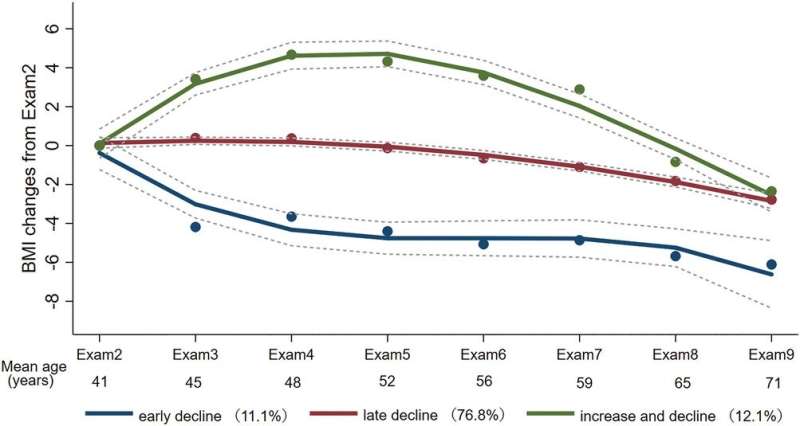Patterns of lifespan weight gain/loss may predict dementia risk
Dementia is a growing global public health concern currently affecting 50 million people and is expected to rise dramatically to more than 150 million cases worldwide by 2050. Obesity, commonly measured by body mass index (BMI), continues to be a global epidemic and earlier studies suggested that obesity at midlife may lead to increased risk for dementia. But the association between BMI and the risk of dementia remains unclear.
“These findings are important because previous studies that looked at weight trajectories didn’t consider how patterns of weight gain/stability/loss might help signal that dementia is potentially imminent,” explained corresponding author Rhoda Au, Ph.D., professor of anatomy and neurobiology.
Through the Framingham Heart Study, a group of participants was followed for 39 years and their weight was measured approximately every 2-4 years. The researchers compared different weight patterns (stable, gain, loss) among those who did and did not become demented.
They found the overall trend of declining BMI was associated with a higher risk of developing dementia. However, after further exploration, they found a subgroup with a pattern of initial increasing BMI followed by declining BMI, both occurring within midlife, which appeared to be central to the declining BMI-dementia association.
Au points out that for individuals, family members, and primary care physicians, it is relatively easy to monitor weight. “If after a steady increase in weight that is common as one gets older, there is an unexpected shift to losing weight post midlife, it might be good to consult with one’s healthcare provider and pinpoint why. There are some potential treatments emerging where early detection might be critical in the effectiveness of any of these treatments as they are approved and become available,” she adds.
The researchers hope this study will illustrate that the seeds for dementia risk are being sowed across many years, likely even across the entire lifespan. “Dementia is not necessarily inevitable and monitoring risk indicators such as something as easy to notice as weight patterns, might offer opportunities for early intervention that can change the trajectory of disease onset and progression.”
These findings appear online in the journal Alzheimer’s & Dementia.
More information: Jinlei Li et al, BMI decline patterns and relation to dementia risk across four decades of follow‐up in the Framingham Study, Alzheimer’s & Dementia (2022). DOI: 10.1002/alz.12839 Provided by Boston University School of MedicineExplore further
Greater weight loss during aging associated with increased risk for MCIby Boston University School of Medicine
 The body mass index (BMI) decline trajectories estimated by group-based trajectory model: (1) declined BMI early from mid-life (11.1%), (2) mid-life stable BMI with a later-life BMI decline (76.8%), and (3) early mid-life BMI increase followed by BMI decline in late mid-life (12.1%). Credit: Alzheimer’s & Dementia (2022). DOI: 10.1002/alz.12839
The body mass index (BMI) decline trajectories estimated by group-based trajectory model: (1) declined BMI early from mid-life (11.1%), (2) mid-life stable BMI with a later-life BMI decline (76.8%), and (3) early mid-life BMI increase followed by BMI decline in late mid-life (12.1%). Credit: Alzheimer’s & Dementia (2022). DOI: 10.1002/alz.12839